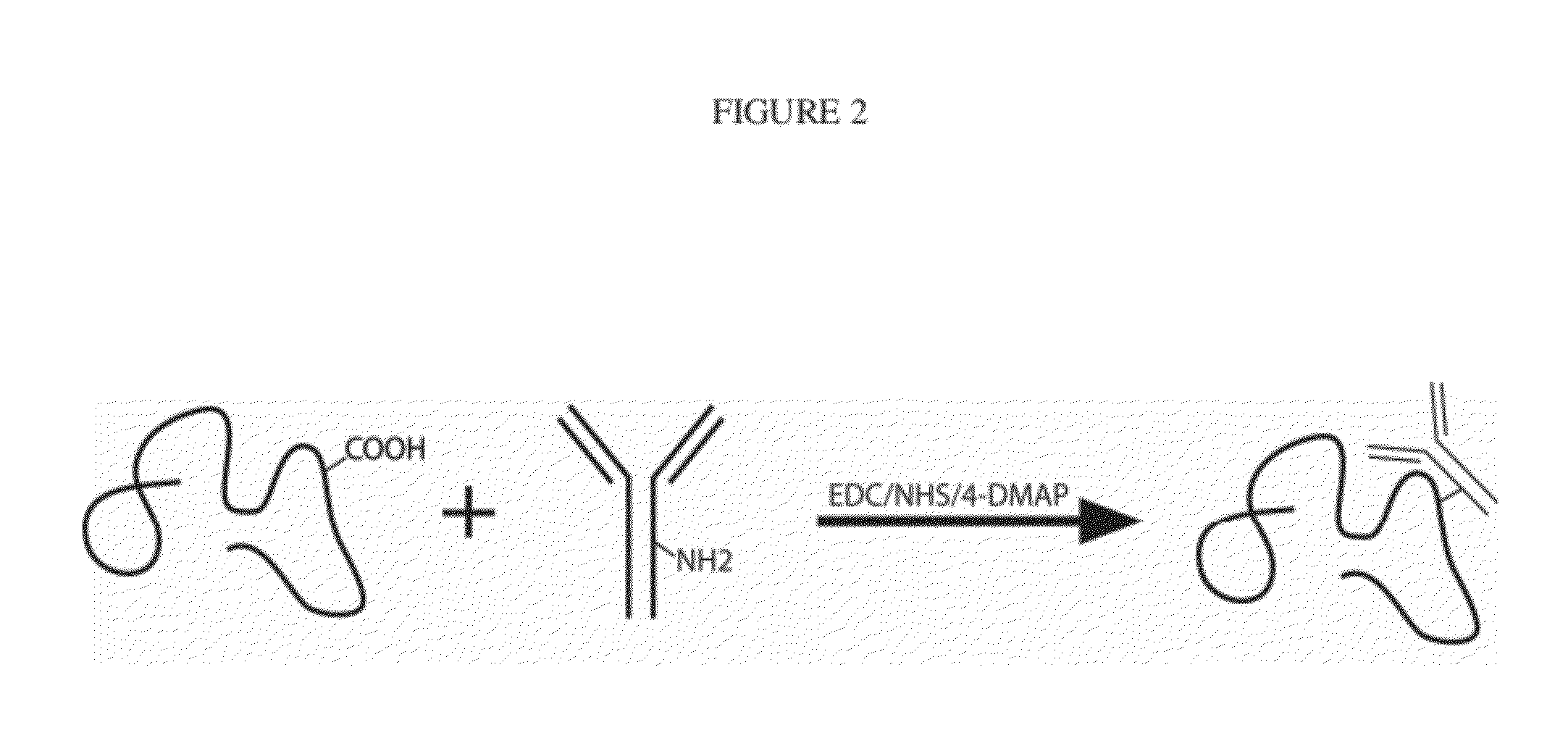Enhanced Binding of Pro-Inflammatory Cytokines by Polysaccharide-Antibody Conjugates
a technology of pro-inflammatory cytokines and conjugates, which is applied in the field of enhanced binding of pro-inflammatory cytokines by polysaccharideantibody conjugates, can solve the problems of weak ecm, prolonging the inflammatory phase, and affecting the effect of cytokine binding affinity, so as to increase the binding affinity of cytokine and reduce the binding affinity
- Summary
- Abstract
- Description
- Claims
- Application Information
AI Technical Summary
Benefits of technology
Problems solved by technology
Method used
Image
Examples
example 1
Preparation of Materials
[0056]Hyaluronic acid (HA, Mw˜1.6 MDa), carboxymethyl cellulose (CMC, Mw˜700 kDa) with 90% carboxylation per CMC monomer (provided by manufacturer), sodium alginate (Mw˜600 kDa), glycidyl methacrylate, N-hydroxysulfosuccinimide sodium salt (sulfo-NHS), N-(3-dimethylaminopropyl)-N′-ethylcarbodiimide hydrochloride (EDC), and 4-(dimethylamino)pyridine (4-DMAP) were purchased from Sigma-Aldrich (St. Louis, Mo.) and used as received. Anti-hIL-1β and anti-TNF-α, both from purified mouse monoclonal IgG1, were purchased from R&D Systems, Inc. (Minneapolis, Minn.) with reported binding affinities for their cytokines of 120 pM. Recombinant human IL-1β (IL-1F2) and human TNF-α were also purchased from R&D Systems, Inc. All reagents were reconstituted and stored according to the manufacturer's instructions.
example 2
Polysaccharide-mAb Preparation
[0057]The first step reaction consisted in the activation of the carboxylic acid in HA, CMC, or alginate. The activated ester intermediates were subsequently used as precursors for the coupling reaction with anti-IL-1β or anti-TNF-α. First, 10 mg of polysaccharide was dissolved in phosphate buffer saline (pH˜7.4) (2 ml). EDC (120 μg, 625 nmol), sulfo-NHS (217 μg, 1 μmol), and 4-DMAP (10 μg) were added as solids to the solution and allowed to dissolve and react overnight before adding mAb. The polysaccharide-NHS active ester is a versatile precursor for bioconjugation with primary amines. Antibodies (0.3 mg) were added to the activated HA solution, and the reaction proceeded at room temperature for 16 h. The solution was then twice precipitated in a saturated solution of ammonium sulfate, and the product was recovered by centrifugation. The pellet was reconstituted in PBS and followed by dialysis (Nest Group, Southborough, Mass.) against pure PBS for 4 h...
example 3
Polyacrylamide Gel Electrophoresis
[0058]A 10 mL solution of 4% acrylamide / bis-acrylamide in 1% TBE buffer was prepared from 40% acrylamide / bis-acrylamide (Sigma) and 10×TBE buffer (Promega, Madison, Wis.). The solution was mixed on a stir plate for 10 min, and followed by adding 50 μl of 10% (w / v) ammonium persulfate and 4 μL of N,N,N′,N′-tetramethylethylenediamine (Sigma). The solution was mixed well and injected into glass plates (Bio-Rad, Hercules, Calif.). The gel set after 30-60 mins. Then 5 μL of each of the standards consisting of 0.1% HA, 0.05% HA, 0.025% HA in the gel were loaded at two different concentrations using 1× and 0.1× stock solutions, and 125V used to electrophorese the gel for 5 h. Gels were stained in 0.5% Alcian Blue (Sigma) with 3% acetic acid for 45 min followed by destaining with 3% acetic acid overnight. Gel images were taken and quantitatively analyzed using Fujifilm LAS-3000 and MultiGauge image analysis software.
PUM
| Property | Measurement | Unit |
|---|---|---|
| concentration | aaaaa | aaaaa |
| concentration | aaaaa | aaaaa |
| concentration | aaaaa | aaaaa |
Abstract
Description
Claims
Application Information
 Login to View More
Login to View More - R&D
- Intellectual Property
- Life Sciences
- Materials
- Tech Scout
- Unparalleled Data Quality
- Higher Quality Content
- 60% Fewer Hallucinations
Browse by: Latest US Patents, China's latest patents, Technical Efficacy Thesaurus, Application Domain, Technology Topic, Popular Technical Reports.
© 2025 PatSnap. All rights reserved.Legal|Privacy policy|Modern Slavery Act Transparency Statement|Sitemap|About US| Contact US: help@patsnap.com



